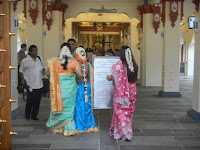

Sri Mariamman Temple & Gopuram Tower (2nd pic)
I wonder if I shall go to the oldest temple in S'pore, in the heart of Chinatown when the private bus was passing by and I spotted the temple just opposite the road where newly bridgegroom was there. I quickly alighted at the bus-stop and saw the oldest temple named 'Sri Mariamman Temple, was built in 1827. It has played an important role in the lives of Hindus here. In the early years, it provided shelter for Indian Immigrants, and was the only Hindu temple whose priests were vested with the authority to solemnise the marriages.


Bridegroom at solemnise ceremony


Musicians on solenmise of marriage of a Bridegroom
I spot and captured the musicians standing on the left side of the hall facing the Sri Mariamman where the Bridegroom stands.
The temple is dedicated to the Mother Goddess Mariamman known for her power in curing epidemic illnesses and diseases. The temple attracted many devotees, who turned to her powers of healing. Sri Mariamman Temple was established by Narayana Pillai, who came to the settlement with Raffles' party in 1819. In 1823, Pillai requested for some land to build a temple, but it was only in 1827 that the 1st temple building was erected. The temples most outstanding feature, the gopuram or entrance tower (see top pic) built in the South Indian Drevidian style, dates from the 1930s. The gopuram rises above the main entrance along South Bridge Road. The present 6 tiered gopuram was built in 1925, was repaired and restored with an elaborate proliferation of scuptures in the 1960s. Sri Mariamman Temple was gazetted a National Monument on 6 Jul 1973 by PMB.


Above photos : Priests in prayer and Goddess Mariamman
The priest is holding prayer at the sanctuary of the bridegroom's marriage which is shown on top of picture.The Main prayer hall is the central shine of Mariamman, which is franked by the shrines of two secondary deities - Rama and Murugan. The main prayer hall is surrounded by a series of free-standing shines, housed in paviion like structures with decorated dome roofs, known as 'Vimana'. These are dedicated to the following deities: Durga, Ganesh, Muthularajah - also known as Mathurai Veeran, a rural Tamil deity, Aravan and Draupadi.


Painting (Frescoes) on the ceilings of the shrine as I look back towards the entrance. (pic above)


Above photo: Flagpole pillar and the bell & drum
The Flagpole pillar is on the side of the courtyard and in relation to the 'gopuram' tower entrance. And the bell is on the left side of the pillar.
Short Brief history of Narina Pilliay: He was the 1st Indian and Tamil Pioneer of S'pore; accompanied Stamford Raffles whom he found him(Pilliay) a dependable, honest and versatile person that Raffles brought him S'pore in 1819; the 1st brick maker and building contractor of S'pore, the earliest Indian community leader of S'pore. Pilliay opened a shop sold cotton goods and later was caught fire in his shop and was bankrupt in 1922. Raffles helped him to restore his fortunes and was clear evidence of Raffles's concern for the tamil pioneer. In early 1823, Pillay obtained his present site to build the Sri Mariamman Temple in South Bridge Road. Actually the 1st site was offered by the government for the Temple was in Telok Ayer Street but there was no fresh water close to the temple.
About Goddess Mariamman - Sri Mariamman can be traced back in 4000 years ago to the Indus Valley civiization of Mohenjo-daro and Harappa in North West and it is believed to be a Dravidian civilization. Sri Mariamman nouishes and protects all beings and is assoicated with rain; she gives life, nurtures and sustains it. She is the source of all energy without which nothing moves in this world; she has various forms which describe her attributes in elopquent appearances.
 Deities with sacred cows
Deities with sacred cowsThe top of the boundary wall that surrounds the compound is lined with sculptures of cows (considered sacred by Hindus)Today, Sri Mariamman temple is best known for the fire-walking ceremony, or Theemithi, that is held every October or November. Devotees would walk on hot coals as a test of their faith and devotion. It is said that in Apr 2010, the temple was re-consecrated following the completion of a S$4M restoration project. A team of about 20 artists were brought in from India for the project, which included repairing all the stone deities.
Your spontaneous visit to the Sri Mariamman Temple beautifully captures the essence of serendipitous exploration. Your vivid descriptions of the temple's rich history, from its establishment by Naraina Pillai in 1827 to its role as a sanctuary for early Indian immigrants, provide a profound insight into its cultural significance. The intricate details you observed, such as the six-tiered gopuram adorned with vibrant sculptures, the ceremonial flagpole, and the sacred shrines dedicated to deities like Mariamman, Rama, and Murugan, highlight the temple's architectural splendor and spiritual ambiance. Your reflections not only showcase the temple's historical and religious importance but also inspire readers to appreciate the deep-rooted traditions and stories that such landmarks embody. Private bus charter Singapore
ReplyDelete